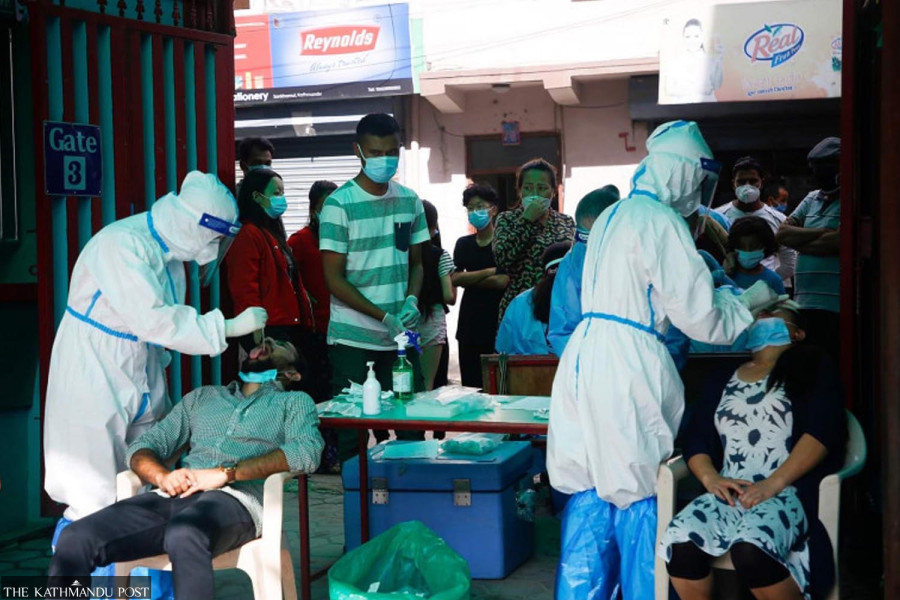Nepal, November 21 -- On December 31, 2019, the World Health Organisation (WHO) office in China received information about a group of pneumo...

Nepal, November 21 -- On December 31, 2019, the World Health Organisation (WHO) office in China received information about a group of pneumonia cases with an unknown origin in Wuhan city, Hubei Province, China, affecting 44 individuals, 11 of whom were in critical condition. At first, the WHO and Chinese officials mentioned that there was no clear proof of transmission between people. However, it was later established that the virus could be transmitted through coughing, sneezing, and respiratory droplets. Infection might occur if someone touched these contaminated surfaces and then touched their eyes, nose, or mouth without proper hand cleaning.
In reality, on June 2, 2020, early in Nepal's encounter with the Covid-19 pandemic, I wrote an article following my observation that SARS-CoV-2, the virus responsible for Covid-19, was spreading quietly within the nation, with most infections occurring without any cough. Even at Sukraraj Tropical & Infectious Disease Hospital, many healthcare workers became infected one after another, despite implementing preventive measures, yet almost none of them exhibited cough symptoms. Interestingly, people with clear coughs were rarely seen in the community, even as the number of infected individuals or positive cases kept increasing throughout the pandemic. Might there have been other ways through which Covid-19 spread, contributing to its quick global spread beyond just coughing or respiratory droplets? This thought-provoking idea brings up important questions among scientists and challenges the traditional understanding of cough as a key symptom of respiratory diseases.
The initial case of Covid-19 in Nepal was identified in January 2020, involving a 32-year-old man who had traveled back from Wuhan, China. During our meeting, he was suffering from difficulty breathing instead of a cough. I spent a minimum of 45 minutes with him (to gather his medical history) without using any personal protective equipment, as his infection with Covid-19 had not been confirmed yet.
Fortunately, further laboratory tests confirmed that I was not infected with the virus. The patient received treatment for symptoms and made a full recovery without any issues. The initial wave of COVID-19 in Nepal was found to be less severe than in neighboring countries and other global regions, with almost all individuals who tested positive showing no symptoms, including the lack of a cough. The second wave, referred to as the Delta wave, which began in India, was more severe than the first wave in Nepal. A considerable number of young people were affected by this wave.
While caring for individuals with Covid-19 in the emergency department, I noticed that the majority of patients did not exhibit a cough; rather, they suffered from difficulty breathing and developed serious pneumonia affecting both lungs, with many passing away within a short period. This could be due to government strategies that focused on vaccinating healthcare workers and older people first, making younger adults more susceptible to severe effects. Notably, the second wave was linked to unusual symptoms, like the loss of smell and taste, which are rarely seen in other respiratory conditions.
Unlike the earlier waves, the third wave, referred to as the "Omicron wave," was marked by typical respiratory signs, such as coughing. Indeed, several people in Nepal initially thought their flu-like symptoms were due to the common cold or seasonal influenza before undergoing tests and confirming they had the Omicron variant. These findings suggest that the first two waves were more intense than the third Omicron wave, although they were distinguished by a lack of significant cough, which is usually linked to respiratory conditions. This change in traditional symptoms made it challenging for doctors to identify Covid-19, often leading to delays in testing and diagnosis. As a result, the prompt introduction of preventive actions was obstructed, enabling the virus to spread more quickly.
Covid-19 stands as one of the most severe pandemics in recent history. It prompted significant inquiries within the scientific field, with many experts forecasting and concurring that the next pandemic, known as 'Disease X,' might resemble a respiratory airborne illness similar to Covid-19. Typically, preventing respiratory infections involves avoiding coughing without a mask, practicing good hand hygiene, and refraining from touching the eyes, nose, and mouth before washing hands. Nevertheless, research on Covid-19 has shown that the virus can also spread through speaking or singing in enclosed areas like rooms, restaurants, or fitness classes. Subsequently, the WHO classified Covid-19 as an airborne disease, which could account for its swift global transmission, possibly due to insufficient awareness or delayed sharing of preventive strategies beyond masks, hand hygiene, and social distancing.
Although cough has long been regarded as a key indicator of respiratory diseases, the Covid-19 pandemic, especially during its initial two waves, has questioned this belief. Its broad influence has led to discussions about a possible change in traditional symptoms, particularly the lack of cough in numerous instances, which presents a major challenge for medical professionals in identifying and addressing future respiratory pandemics similar to Covid-19. This could even require reevaluating whether cough should be included in the criteria for diagnosing respiratory conditions. Therefore, there is a requirement for more extensive, high-quality research to enhance our understanding of how Covid-19 spreads, especially if it involves pathways that go beyond what we currently know. These findings would help in developing more efficient strategies to control the virus's spread and implementing more precise prevention methods.
Significantly, numerous specialists expect that the next 'Disease X' or global health crisis might resemble a respiratory airborne illness similar to Covid-19. Therefore, a thorough examination of how Covid-19 spreads is essential for prompt and efficient management of outbreaks or pandemics, as it is impossible to control any infectious pathogen without a deep understanding of its transmission patterns.



